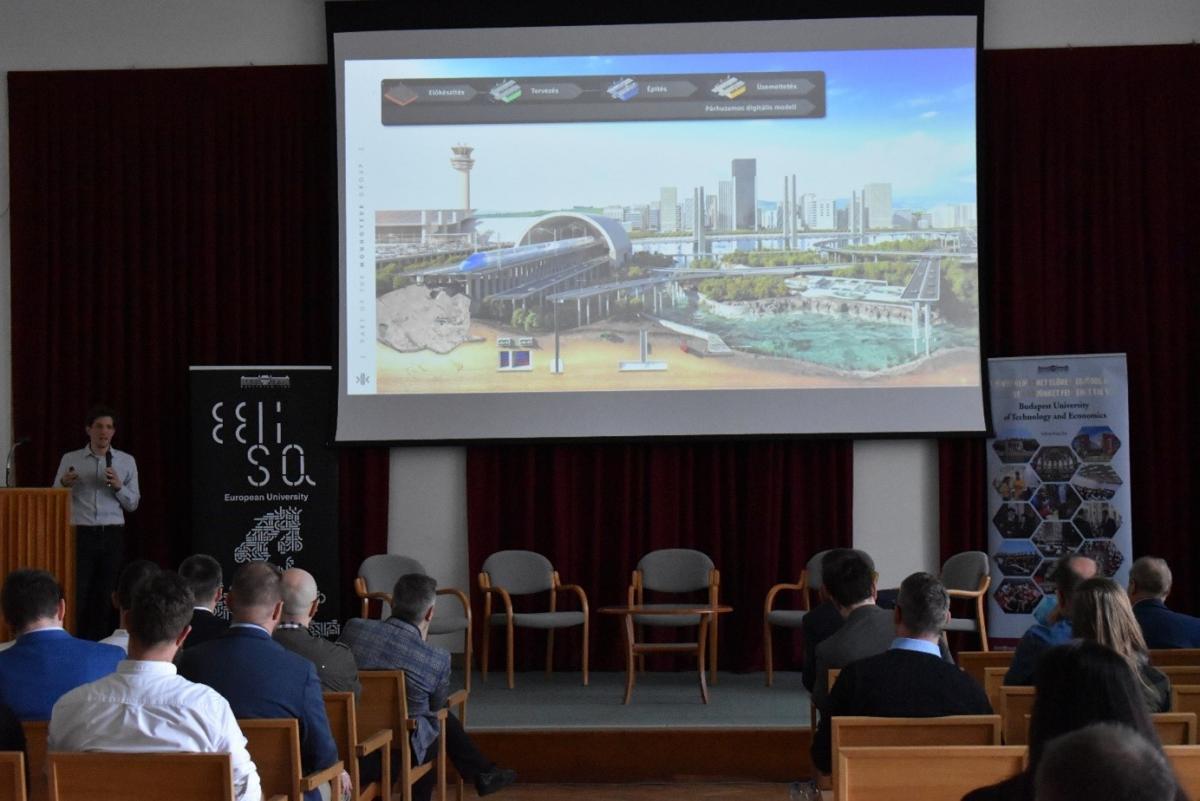2024. April 20.
DIGITWINS Conference - training and innovation in the service of Infrastructure digitalization
DigitTwins 2024 Conference at the Faculty of Civil Engineering - Enhanced Engagement and Outstanding Presentations
The second annual DigiTwins conference, hosted by the Faculty of Civil Engineering at BME, focused on fostering collaboration among designers, construction companies, and operators of transport facilities and complex urban infrastructures to showcase innovative solutions and exchange experiences. This year's conference stood out in multiple ways, not only featuring technical presentations but also providing a comprehensive overview of the current state of the construction industry and the regulatory framework surrounding the implementation of BIM methodology in Hungary. At the conference's conclusion, participants engaged in an informal panel discussion with leading infrastructure design firms, an IT and engineering services company, and the Hungarian Chamber of Engineers to address the forthcoming challenges in infrastructure digitization.
The conference was opened by Dr. Szabolcs RÓZSA, Dean of the Faculty of Civil Engineering, followed by a presentation by Dr. Tamás LOVAS on the development of the Faculty of Civil Engineering and the current results of the DigiTwin4CIUE international master's programme launched in autumn 2023.




In his presentation, Ministerial Commissioner Gábor DÁNYI highlighted the unique nature of the Hungarian BIM framework, as it relies heavily on feedback from industry. The ascending regulatory system, with the involvement of industry in working committees, allows for continuous consultation and the incorporation of feedback into the detailed rules. Particular emphasis has been placed on learning from existing international regulations and best practice in order to accelerate domestic implementation, while of course taking into account specific domestic needs and requirements.

In its presentation, ÉVOSZ summarised the situation of the Hungarian construction industry in European comparison, analysed the most important economic indicators of the past years and drew attention to the most important cornerstones for shaping the future.


In its interactive presentation, UVATERV Zrt. highlighted the application of BIM methodology throughout the project preparation and study design phases. The presentation underscored the necessity for BIM-compatible, up-to-date inventory databases to accurately map out project challenges during the preparation phase. It showcased numerous examples of 3D simulations, visualizations, and variant comparisons in the design and plan commenting stages, all contributing significantly to effective decision-making. Furthermore, the use of 3D models was emphasized as a means to enhance transparency and facilitate approval during the plan endorsement phase.

During their presentation, UNITEF'83 Zrt. showcased the application of BIM software solutions in both the permitting and design stages, using a real road construction project as an example. The presentation highlighted the collaborative potential across disciplines and emphasized the necessary enhancements to reach the desired level of automation in road BIM design.

In their presentation, FÖMTERV Zrt. shared valuable insights from a BIM road construction model project. They explored the extent to which an InfraBIM project can and should achieve in terms of functionality and cost-effectiveness, considering the level of detail. They also addressed the expectations for interoperable data and document management and the strategies to meet these expectations. These topics were thoroughly discussed through a detailed report and an extensive analysis of the underlying issues.

Arkance Systems Ltd. showcased InfraBIM software solutions that span the entire lifecycle of infrastructure projects across multiple disciplines, including road construction, railway construction, and utilities. The presentation focused on "Scan to BIM" workflows applicable in the pre-design and construction phases. Additionally, it highlighted the viability of a shared data environment and the advantages of cloud-based workflows.

In their presentation, Hungarian State Railway (MÁV) demonstrated the potential of DigiTwin technology for railway applications through various examples of both existing and developing projects. The session provided insights into machine learning-enhanced railway video inspection systems and showcased Lidar surveys processed with automatic object recognition and integrated into geographic information systems. Additionally, the presentation highlighted innovative applications in railway operations, such as overhead line zig-zag detection and vehicle gauge inspection capabilities.

Budapest Közút Zrt. presented their data collection and data publishing solutions, the functions and services of the KARESZ and KAPU systems, and the application possibilities of the DigiTwin technology in an urban environment through some highlighted examples.

The presentation by the BME Department of Structural Engineering provided a detailed overview of continuous, real-time monitoring of bridge structural conditions and the capabilities of bridge load analysis using DigiTwin technology. The lecture highlighted practical examples of measurement solutions and simulation procedures derived from these solutions, aimed at optimizing bridge lifespan and ensuring structural safety.
The conference ended with a panel discussion where the leaders of renowned infrastructure design firms, a group of companies involved in software development, IT solutions and engineering consultancy, and the President of the Hungarian Chamber of Engineers discussed the tasks and challenges ahead in the field of infrastructure digitisation.
On behalf of the organizers, we extend our heartfelt gratitude for your tremendous interest in our conference. We are delighted to announce that this year's event has exceeded expectations, with participation numbers doubling compared to last year's DigiTwin miniconference, boasting an attendance of over 140 individuals. Your enthusiastic engagement and support have contributed significantly to the success of this gathering, and we look forward to continued collaboration and growth in the future.
Presentations at the conference:
